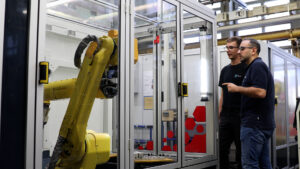 LMT Tools (Schwarzenbek, Germany) is one of the most renowned specialists for the production, sales and development of precision tools and has 1,200 employees worldwide. Production and development are carried out by LMT Onsrud, LMT Belin, LMT Kieninger and LMT Fette and the sales companies are active worldwide. LMT Fette was founded in 1908 and specializes in gear cutting, rolling, milling and threading.
LMT Tools (Schwarzenbek, Germany) is one of the most renowned specialists for the production, sales and development of precision tools and has 1,200 employees worldwide. Production and development are carried out by LMT Onsrud, LMT Belin, LMT Kieninger and LMT Fette and the sales companies are active worldwide. LMT Fette was founded in 1908 and specializes in gear cutting, rolling, milling and threading.
“We offer an extensive range of standard and special tools and are one of the leaders in the fields of gear cutting tools and rolling tools. Our customers are mainly from the general mechanical engineering, energy technology, automotive, medical technology, aerospace technology and die mold industries, said Uwe Kretzschmann, Head of R&D at LMT Fette.
Market trends guide product development and LMT’s unique tool options
“Product development, and thus the entire innovation management process has a very high priority, and our development focus is of course based on market needs. On the other hand, we also look at technological and economic trends, for example, the technological change taking place in the automotive industry, but also the approach of additive manufacturing, and digitalization. For the latter, for example, we have developed intelligent tools that can record and exchange data, leading the way to building a Smart Factory,” explained Uwe Kretzschmann.
Dr. Islam Bayoumi is the Team Leader, Process Optimisation, he said: “The market is increasing very quickly for different sectors such as the automotive industry. We have the new development of the electrical motor and we have in Germany a lot of production sites in this direction – of electrical mobility. There are a lot of producers for the electric motor – not only for the motor, but also for the old mechanical parts in the car and these mechanical parts need cutting tools.”
“I think a big change is to the digital cutting tools. So, the cutting tools with small microprocessors to calculate the tool life of the cutting tools or to measure the craft or the power by the machining operations, like a milling operation or turning operation. I think this sector has a big market or the market will be changing very quickly in this direction.”
Andreas Möller, Product Manager, added: “The threading market worldwide is huge and we are a small player in this market but we have some great tools that our competitors don’t have, for example, our modular tools like HPF, which is also manufactured on the ANCA machines. So, we have a USP and the patent for these tools. And this is something unique that the competition doesn’t have.”
Product development for LMT tools is particularly important and the company has a range of processes to underpin this. LMT has an international product development team that shares ideas collectively and collaborates for the best possible development benefits. They also have a development roadmap, where products are developed in the long term, so that the renewal rate of the products is carried out continuously.
Matching machine and software performance with production goals is made possible with ANCA machines
Dr. Bayoumi said: “The main focus for us is to provide a high quality tool performance, the precision and the and the accuracy of the tolerance as well as the optimum geometry to cut the material in order to preserve the tool life as long as we can.”
“We have three ANCA TX machines in our production site which allows us to produce different dimensions of cutting tools.”
“One of the challenges is the reduction of the manufacturing costs according to increasing material prices and the labor costs and so on. We try to keep our production costs as low as we can, and we can provide this using the automation options provided by ANCA.”
“Automation means that the operator can operate two or three machines at the same time, we use a robot system for changing the work pieces as well as changing the grinding wheels.”
“At first, we test our new products using simulation and then we test live because we must also measure the outcome. The grinding software, iGrind, allows our operators to create the grinding programs efficiently and easily.”
Uwe Kretzschmann confirms the suitability of ANCA machines for LMT production needs: “The ANCA machines match the requirements for the tool types that we make. They have a high degree of flexibility due to the easy automated change of grinding wheel packs. They are very robust machines and are very suitable for technology development.”
“For these tool requirements, it is particularly important to use a production machine during the development process and during the production of the first prototypes. We chose an ANCA machine, because the iteration loops when producing the first tools at the beginning of the development process is possible. It is important that this can be done on a production machine.”
“The support of the machine manufacturer is of course very important, and we are happy with the service and cooperation we have received from ANCA.”
About ANCA
ANCA is a market-leading manufacturer of CNC grinding machines. It was founded in 1974 in Melbourne, Australia where the company still has its global headquarters. ANCA has offices in the UK, Germany, China, Thailand, India, Japan, Brazil, and the USA as well as a comprehensive network of representatives and agents worldwide.
ANCA CNC grinders are used for manufacturing precision cutting tools and components across a diverse range of competitive industries including cutting tool manufacture, automotive, aerospace, electronics, and medical.










































